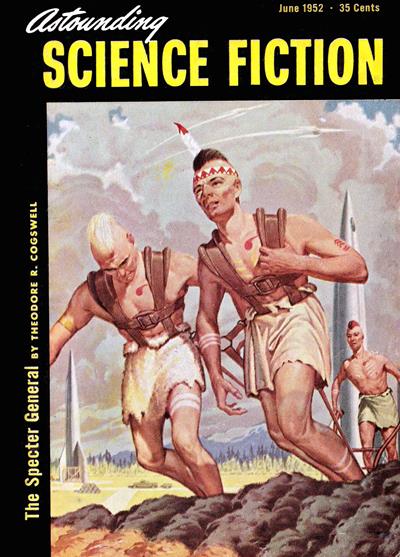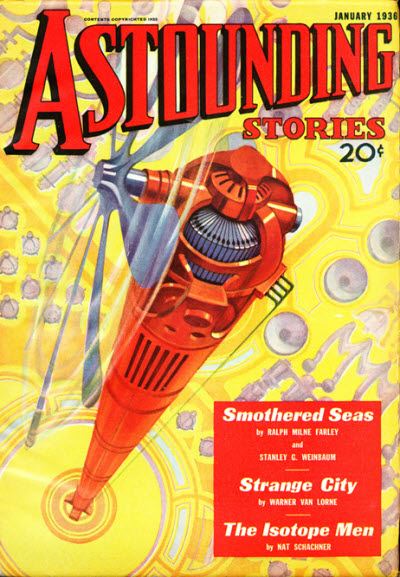
Part of Series
Vol 30, No 2. Contents: 6 • The Last Stand • [Editorial (Astounding)] • essay by John W. Campbell, Jr. [as by The Editor] 9 • Lunar Landing • novelette by Lester del Rey 32 • Warriors' Age • novelette by Peter Risk 40 • The Analytical Laboratory: August 1942 (Astounding, October 1942) • [The Analytical Laboratory] • essay by The Editor 41 • The Second Solution • [Rull] • novelette by A. E. van Vogt 50 • The Paris Gun • essay by Willy Ley 56 • Anachron, Inc. • [Anachron] • novelette by Malcolm Jameson 83 • In Times to Come (Astounding, October 1942) • [In Times to Come (Astounding)] • essay by The Editor 85 • The Wabbler • short story by Murray Leinster 90 • Late-Model Stars • essay by R. S. Richardson 100 • The Beast • novelette by L. Ron Hubbard 108 • Brass Tacks (Astounding, October 1942) • [Brass Tacks] • essay by The Editor 108 • Letter (Astounding, October 1942) • [Letters: L. Sprague de Camp] • essay by L. Sprague de Camp 109 • QRM - Interplanetary • [Venus Equilateral] • novelette by George O. Smith. 【 PREVIOUS ISSUE ← October 1942 → NEXT ISSUE 】
Authors
George Oliver Smith (April 9, 1911 - May 27, 1981) (also known as Wesley Long) was an American science fiction author. He is not to be confused with George H. Smith, another American science fiction author. Smith was an active contributor to Astounding Science Fiction during the Golden Age of Science Fiction in the 1940s. His collaboration with the magazine's editor, John W. Campbell, Jr. was interrupted when Campbell's first wife, Doña, left him in 1949 and married Smith. Smith continued regularly publishing science fiction novels and stories until 1960. His output greatly diminished in the 1960s and 1970s when he had a job that required his undivided attention. He was given the First Fandom Hall of Fame award in 1980. He was a member of the all-male literary banqueting club the Trap Door Spiders, which served as the basis of Isaac Asimov's fictional group of mystery solvers the Black Widowers. Smith wrote mainly about outer space, with such works as Operation Interstellar (1950), Lost in Space (1959), and Troubled Star (1957). He is remembered chiefly for his Venus Equilateral series of short stories about a communications station in outer space. The stories were collected in Venus Equilateral (1947), which was later expanded as The Complete Venus Equilateral (1976). His novel The Fourth "R" (1959) - re-published as The Brain Machine (1968) - was a digression from his focus on outer space, and provides one of the more interesting examinations of a child prodigy in science fiction.


Lester del Rey was an American science fiction author and editor. Del Rey is especially famous for his juvenile novels such as those which are part of the Winston Science Fiction series, and for Del Rey Books, the fantasy and science fiction branch of Ballantine Books edited by Lester del Rey and his fourth wife Judy-Lynn del Rey. Also published as: Philip St. John Eric van Lihn Erik van Lhin Kenneth Wright Edson McCann (with Frederik Pohl)
Pseudonym: Philip Latham Biography on Wikipedia.

Alfred Elton van Vogt was a Canadian-born science fiction author regarded by some as one of the most popular and complex science fiction writers of the mid-twentieth century—the "Golden Age" of the genre. van Vogt was born to Russian Mennonite family. Until he was four years old, van Vogt and his family spoke only a dialect of Low German in the home. He began his writing career with 'true story' romances, but then moved to writing science fiction, a field he identified with. His first story was Black Destroyer, that appeared as the front cover story for the July 1939 edtion of the popular "Astounding Science Fiction" magazine.

Malcolm Jameson began writing only seven years before his death. Yet in that short span he wrote and sold more than 70 novelettes and short stories. Critic Groff Conklin calls Jameson's work "lively, ingenious and readable." The majority of Jameson's work appeared in the magazines "Astounding Science Fiction" and "Unknown Worlds" but he was also published in a number of the other pulp magazines of the late 1930's and early 40's. His novella "Blind Alley", first published in the June 1943 issue of Unknown, was the basis for the Twilight Zone episode "Of Late I Think of Cliffordville" starring Albert Salmi, John Anderson, and Julie Newmar. The hour-long episode was broadcast on April 11, 1963.

Lafayette Ronald Hubbard With 19 New York Times bestsellers and more than 350 million copies of his works in circulation, L. Ron Hubbard is among the most enduring and widely read authors of our time. As a leading light of American Pulp Fiction through the 1930s and '40s, he is further among the most influential authors of the modern age. Indeed, from Ray Bradbury to Stephen King, there is scarcely a master of imaginative tales who has not paid tribute to L. Ron Hubbard. Then too, of course, there is all L. Ron Hubbard represents as the Founder of Dianetics and Scientology and thus the only major religion born in the 20th century. While, as such, he presents the culmination of science and spiritual technology as embodied in the religion of Scientology. For an in-depth look at his life, visit www.LRonHubbard.org


